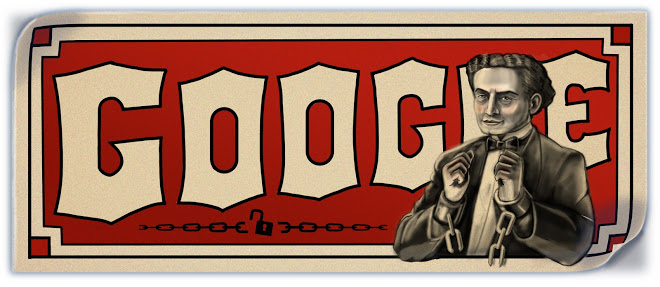Harry Houdini Google Doodle

Thursday March 24th 2011 saw the Google homepage pay doodle based tribute to one of the greatest illusionists the world has ever seen, Harry Houdini. The doodle, which appeared on the search engine’s homepage globally, celebrated what would have been Houdini’s 137th birthday. The dedicated doodle, which can still be viewed by clicking here, featured an animated depiction of Houdini with chains on his wrists. In the background the Google logo appeared on a red banner in white writing.
 Houdini’s birth name was Ehrich Weiss and he was born on 24th March 1877, he was born in Budapest, Hungary. His father was a Rabbi and Houdini had six siblings, five brothers and one sister. His family later relocated to America, aboard the SS. Fresia, which landed in the U.S. on July 3rd 1878. Upon arrival in America the family initially settled in Appleton, Wisconsin, where his father served as the Rabbi of a Zion Reform Congregation.
Houdini’s birth name was Ehrich Weiss and he was born on 24th March 1877, he was born in Budapest, Hungary. His father was a Rabbi and Houdini had six siblings, five brothers and one sister. His family later relocated to America, aboard the SS. Fresia, which landed in the U.S. on July 3rd 1878. Upon arrival in America the family initially settled in Appleton, Wisconsin, where his father served as the Rabbi of a Zion Reform Congregation.
The magic career of Houdini began in 1891 and initially he enjoyed little success. He began performing in dime museums and sideshows, moonlighting as “The Wild Man” in order to support his income. Initially Houdini focussed on traditional card tricks and called himself the “King of Cards”, however he quickly began to experiment with escape acts.
As an escape artist Houdini performed a number of notable escapes, including the Mirror challenge. For this escape he was challenged by the British newspaper The Mirror to escape from a pair of specially made handcuffs which they claimed had taken a locksmith over five years to create. It took Houdini over one hour and ten minutes to escape from the handcuffs, after which he was paraded around on the shoulders of the cheering crowd.
1901 saw Houdini unveil his own trick, the Milk Can Escape. As part of this act Houdini was handcuffed and placed in an oversized milk can which was filled with water from which he escaped. Following the emergence of a number of other magicians also performing the Milk Can Escape Houdini devised the Chinese Water Torture Cell. This escape involved Houdini’s feet being locked in a set of stocks. Houdini was then lowered upside down into a tank filled with water. Houdini named the escape trick “the Upside Down” and he first performed the trick at the Circus Busch in Berlin on September 21st 1912.
 Another notable escape trick which Houdini performed was the Buried Alive stunt. During his career Houdini performed at least three different variations of this stunt. The first time this stunt was performed was in California in 1915 and it nearly killed him. To perform the first Buried Alive stunt Houdini was buried six feet underground without a casket and then clawed his way to the surface.
Another notable escape trick which Houdini performed was the Buried Alive stunt. During his career Houdini performed at least three different variations of this stunt. The first time this stunt was performed was in California in 1915 and it nearly killed him. To perform the first Buried Alive stunt Houdini was buried six feet underground without a casket and then clawed his way to the surface.
Later adaptations of this stunt involved Houdini being buried underwater in a casket and holding his breath for varied periods of time. He initially performed this stunt in order to beat the Egyptian performer Rahman Bey, who had claimed he was able to remain in a sealed casket for half an hour using his mystical powers. Houdini outperformed Bey on 5th August 1926 by remaining submerged in a casket for a total of an hour and a half. Houdini claimed that no trickery had been used to perform this feat and that he had merely used controlled breathing techniques.
Houdini died at the age of 52 as the result of peritonitis which resulted from a ruptured appendix on October 31st 1926 at 1:30pm. His last words were reported to have been “I’m tired of fighting”. Over 2000 mourners were in attendance at Houdini’s funeral, which was held in New York City on November 4th 1926.
